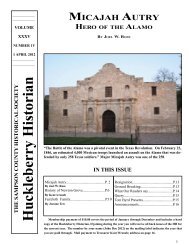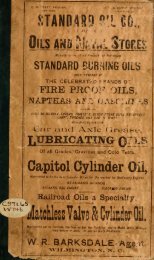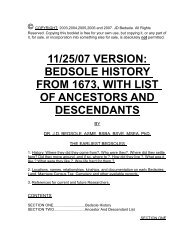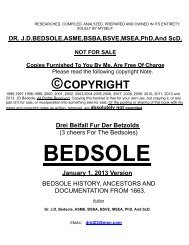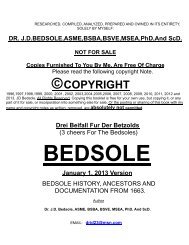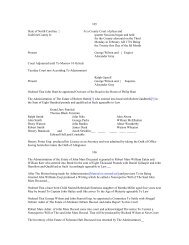Bedsole - NCGenWeb
Bedsole - NCGenWeb
Bedsole - NCGenWeb
Create successful ePaper yourself
Turn your PDF publications into a flip-book with our unique Google optimized e-Paper software.
Not being a member of the church meant that person would not be able to trade their goods for things they<br />
and their family desperately needed. In addition, they could not count on the help and support of church<br />
members, and that fact alone was usually so devastating, it was enough to get the wayward member to<br />
mend his ways. Church members enjoyed many important benefits such as; When anyone got sick, or<br />
injured, everyone gathered there and did whatever they could to help care for the party in need, including<br />
caring for babies and children, the family, cooking, milking cows and doing all the farming, cultivating,<br />
planting, harvesting and other chores normally done by that family. Knowing that tomorrow, the person in<br />
need could very well be any one of them, this practice was looked on as a very valuable thing to have in<br />
ones life, together with the ability to trade among themselves. Caring for each other meant survival, living or<br />
dying, in many cases.<br />
When a member in good standing, moved to another location, they could request a letter of transfer from<br />
their local church to the church at their new location and stay in good graces with the church. However, they<br />
were only allowed 30 days to be accepted into the new church. Preachers and pastors were key people in<br />
everyone’s lives and were always treated with the utmost respect and courtesy and were especially cared for<br />
by all the families in the area. It was common practice to invite the Preacher and his family to ones house for<br />
Sunday dinner where the host family always prepared the best food they had for the meal and the guest(s).<br />
Velvet Beans<br />
Picking Velvet Beans was pure torture. They were planted among the corn, so the vines would have<br />
something to grow and run up on and multiply. They were used primarily for cattle feed. Picking velvet beans<br />
was one of the most despicable jobs, next to cotton. The beans are all covered with a thick coating of small<br />
velvety hairs which all have reversed barbs all along the hair, so if the hair sticks in your skin which it will, the<br />
thing could not be pulled out and would break off instead, resulting in skin itching and infections.<br />
The itching and stinging of the skin were horrendous and impossible to describe. The settlers all wore heavy,<br />
thick, guano sack shirts and the thickest pants they had, which were usually made of leather or hides. The<br />
legs were tied around the ankles really tight. The shirt collars were buttoned all the way up. The shirt sleeves<br />
were rolled all the way down and tied tight around the wrists. Still, the velvet got inside the shirts, up the<br />
sleeves, up the pants legs, and inside the clothes. With the weather around one hundred degrees in the<br />
summer and the humidity at about ninety-five percent and these beans being down among the corn where no<br />
breeze could get to the workers, picking them dressed as they were, was pure torture for days on end. The<br />
weaker workers frequently fainted from aggravation and heat exhaustion.<br />
Gathering Corn<br />
The ears of corn had to be pulled from the stalks and put in a sack with a strap which was worn around the<br />
neck. The leaves on corn stalks are also lined on each side of the leaf with reversed needle-like stingers and<br />
a leaf will cut ones skin like a knife. Then the sweat would get in the cuts and burn like fire. By the time they<br />
had been carrying that fifty pound bag of corn around their necks and dumping it in the wagon for twelve<br />
hours, their shoulders and backs would be throbbing and hurting so badly, they could hardly keep from<br />
crying. Working among the stalks of corn meant no breeze could get to them and the heat was torture. Every<br />
time their sacks were full, it was carried and emptied into the mule-drawn wagon. When the wagon was full,<br />
PAGE TWENTY EIGHT<br />
the corn was hauled to the barn and unloaded and stored inside. With one hundred or more, acres of corn,<br />
this was no small job. Corn was used primarily for animal feed and for meal and human consumption in the<br />
form of cornbread. If the family had children age five or higher, they did much of this work. Its hard to imagine



